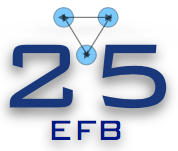Conveners
Monday Parallel Session: Lattice QCD and relativity (Linke Aula)
- Harvey Meyer
I will discuss a new method to compute light-front wave functions and parton distributions using contour deformations. After solving the two-body Bethe-Salpeter equation of a scalar theory, the projection onto the light front is done through a combination of contour deformations and analytic continuation methods. The resulting light-front wave functions and distribution amplitudes are in...
We discuss a systematic method for constructing many-body electromagnetic current operators that are needed to ensure covariance and current conservation in phenomenological relativistic Hamiltonian models of
strongly interacting systems. The construction represents a general Hamiltonian in the Weyl representation. Momentum operators in this representation are replaced by gauge covariant...
The constituent quark models successfully explain the features of the single hadrons. The hadron interactions are also well-reproduced. For example, the channel dependence of the short-range part of two-baryon interaction corresponds to those given by the Lattice QCD.
In this work, we investigate the exotic hadrons, ($q \bar q$)-($q \bar q$). The spin-dependent term of the one-gluon...
Baryon interactions, including nuclear force, are an essential component in nuclear physics especially in studies of few-body systems. There are already some useful phenomenological nuclear forces, thanks to a lot of experimental data. While, we suffer from uncertainty in hyperon interactions due to a lack of experimental data. In such case, it is very useful if we could derive baryon...
We solve the Faddeev bound-state equations for three particles with simple two-body nonlocal, separable po- tentials that yield a scattering length twice as large as a positive effective range, as indicated by some lattice QCD simulations. Neglecting shape parameters, the two-body bound state is a double pole. For bosons we obtain a cor- relation between three- and two-body energies. For...
We propose a systematic approach to study the nucleon-nucleon interaction by applying time-ordered perturbation theory (TOPT) to covariant chiral effective field theory. Diagrammatic rules of TOPT, for the first time, are worked out for particles with non-zero spin and interactions involving time derivatives. They can be applied to derive chiral potentials at any chiral order. The effective...

